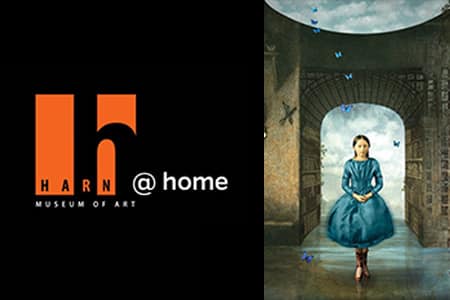Visual Storytelling Inspired by Dreaming Alice
How can we tell a story through art? Maggie Taylor is a Gainesville, Florida based artist known for her unique approach to photography. Instead of using a camera, Taylor scans objects she collects then arranges and manipulates the scanned files in Adobe Photoshop to create dream-like images. Inspired by “Through the Looking-Glass, and What Alice Found There” by Lewis Carroll, Taylor digitally illustrates the characters, settings and sequences of events depicted throughout the book. Her visual interpretation of Carroll’s whimsical tale is on display in Dreaming Alice: Maggie Taylor Through the Looking-Glass.
You can create a fantastic tale of your own by following Taylor’s practice of collecting, arranging and capturing. Using a camera and an assortment of objects found throughout your home, photograph a visual story that has a beginning, middle and end. Then post your three-part photo story in the Family Day Facebook event. Find inspiration in everyday objects by transforming the ordinary into the extraordinary! What curious story will you capture to share with your museum community?
What You’ll Need
-
- A digital camera or camera phone
- An assortment of objects
What You’ll Do
- Identity a story with characters, a setting and a sequence of events. Who will be in your story? Where will your story take place? What will happen in your story?
Need inspiration? Consider these prompts to spark your creativity:- Tell a story about…
- A favorite nursery rhyme.
- A magical creature.
- A recent dream.
- An amazing transformation.
- An epic adventure.
- An unknown land.
- An urban legend.
- Collect unique objects found in your home to create a background, characters and props that help tell your story.
Need inspiration? Maggie Taylor often uses photographs, insects, dolls, plants and animals to create images. Transform the ordinary to the extraordinary by including a variety of objects: anything old looking, blankets and pillows, book covers, chess and checkers boards, drawings, elements from nature: shells, leaves, flowers, stones, fruits and vegetables, holiday garland, maps, photographs of you, your pets or family members, playing cards, polaroids, potted plants, reflective surfaces: mirrors, glassware, eyeglasses or tin foil, stuffed animals, tea sets and cups, various patterns and textures or toys. - Arrange collected objects to set your first scene. In the beginning of a story, we can discover the “W’s,” such as the Who, Where, When and Why. Start your photo-story by capturing this scene with a camera.
- Rearrange, add and/or remove objects to set your second scene. All stories have a middle. A middle part may contain a challenge of some sort. Continue your photo-story by capturing this scene with a camera.
- Rearrange, add and/or remove objects to set your third scene. All stories have an ending. An ending has a resolution and like life, it may be a happy ending or a not so happy ending. Complete your photo-story by capturing this scene with a camera.
- Upload your three images to the Family Day Facebook Event page to show off your curiouser and curiouser photo-based visual story!
Challenge: Want to take your photo-based visual story to the next level? Photograph objects in your home then upload them into editing software, like Adobe Photoshop, to digitally manipulate. Experiment with layers, opacities, color saturation and more to construct Dreaming Alice-inspired images of your own.


